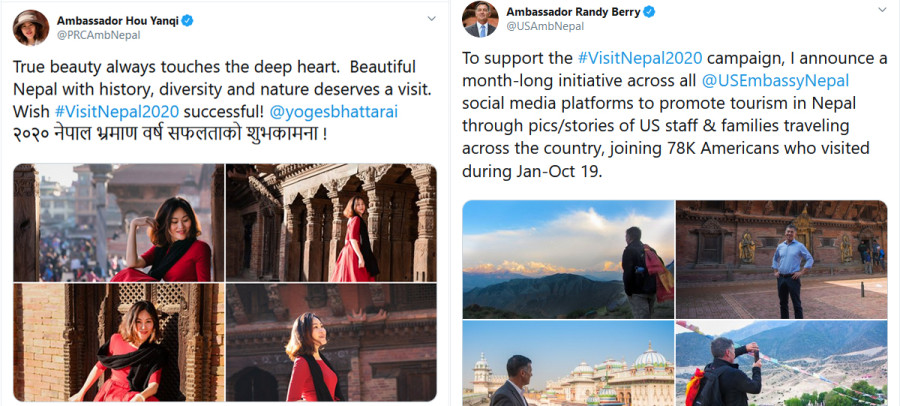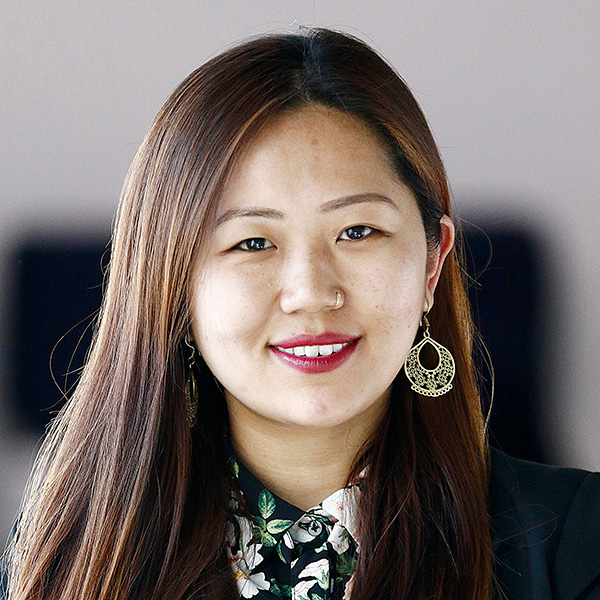National
Diplomats take to social media to promote Visit Nepal 2020, and beyond
Analysts say diplomats using social media to push diplomacy is fine as long as it doesn’t affect Nepal’s domestic policies.
Bhrikuti Rai
A day before the government rang in the new year and inaugurated Visit Nepal 2020 with an ostentatious display of fireworks and marching bands, Twitter was already abuzz with Visit Nepal posts, courtesy of the Chinese Ambassador to Nepal.
Ambassador Hou Yanqui’s post, accompanied by her pictures from Patan Durbar Square, led to hundreds of replies, a majority of them thanking her for helping promote Nepal. A small section of Nepali Twitter users even complained about her “model-like photo shoot” which they deemed inappropriate for a diplomat.
Irrespective of the responses her tweets elicited, the post proved effective—leading to hundreds of retweets and also a number of articles in the local media praising Hou’s efforts to help promote Nepal. Hou joined Twitter—a platform banned in China—last year and has over 13,000 followers. She provides regular updates on China-assisted projects in Nepal along with ubiquitous festival greetings.
The positive feedback that Hou’s tweets often receive is the reason why top diplomats, including the generally media-shy Chinese diplomatic corps, have flocked to social media and use the platforms aggressively to further public diplomacy, say foreign policy analysts.
“Social media is an excellent platform to earn goodwill at the public level and foreign ambassadors here are using it effectively to gain popularity,” said Indra Adhikari, former deputy executive director of the Institute of Foreign Affairs, a think tank under the Ministry of Foreign Affairs. “These platforms have in many ways changed the traditional ways of diplomacy.”
On Thursday, outgoing Indian Ambassador to Nepal Manjeev Singh Puri wrote a farewell tweet, thanking Nepal for “great memories and wonderful friendships”. And just last November, Nicola Pollitt, the British ambassador to Nepal, announced her stint in Nepal through Twitter. Since then, Politt has been using Twitter to post updates about her meetings with Nepal’s leaders, and speak about issues like climate change and press freedom.
Adhikari adds that countries like the US and China, who are both competing for influence on the world stage and more increasingly in Nepal, are using social media to wield soft power. And often, this competition is showcased on platforms like Twitter.
Randy Berry, the US Ambassador to Nepal, who, like his predecessor Alaina B Teplitz, uses social media extensively to share his travel pictures from Nepal, and also regularly interacts with the four million-plus followers of the US Embassy’s various social media pages.
But on Thursday, days after Hou tweeted pictures of herself in support of Visit Nepal 2020, Berry followed suit, tweeting a similar post with his own travel pictures, announcing “a month-long initiative across all US Embassy Nepal social media platforms to promote tourism in Nepal”.
Unlike a lot of ambassadors in town, Berry also uses his social media platform to speak about political issues, especially those concerning United States’ foreign policy, including the much-talked-about Indo-Pacific Strategy.
Last week Ambassador Berry shared an article on Twitter, “applauding” the Nepal government’s decision to shut down North Korean businesses in Kathmandu.
Analysts, however, say that the Nepal government should remain watchful about the activity of ambassadors on social media, especially the political statements that they make.
“Conflicting statements made on social media by powerful countries on issues and policies concerning Nepal could be a headache for the country,” said Vijay Kant Karna, a political scientist who served as Nepali ambassador to Denmark. “Diplomats using social media to further public diplomacy in Nepal isn’t something to worry about as long as it doesn’t influence the country’s domestic politics and policies.”




 12.12°C Kathmandu
12.12°C Kathmandu













%20(1).jpg&w=300&height=200)

